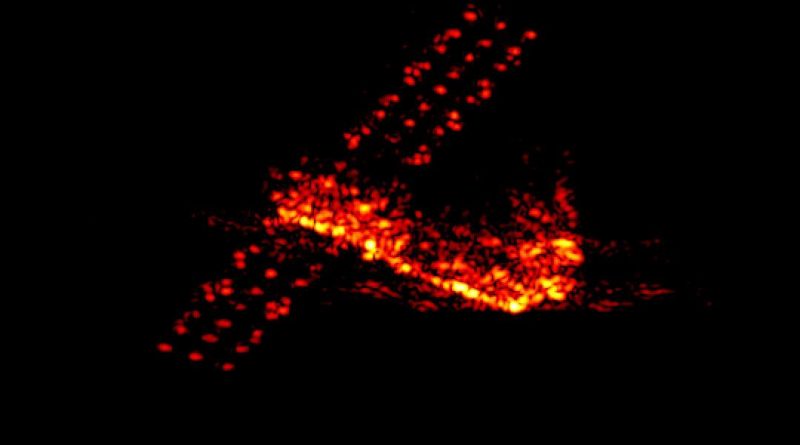Abandoned Chinese Space Laboratory Re-Enters Harmlessly over Pacific Ocean
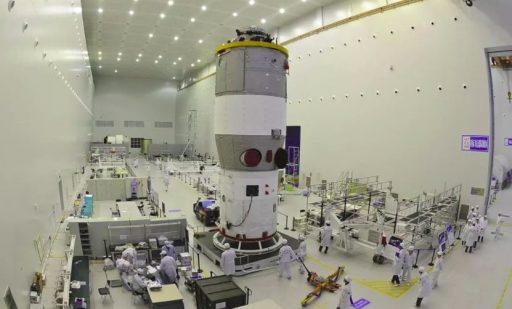
China’s abandoned Tiangong-1 space station met its fiery end in the early hours of Monday when re-entering Earth’s atmosphere after 2,376 days in orbit, serving as a stepping stone toward a large modular Space Station China plans to deploy in 2020. The seven-and-a-half metric ton space laboratory re-entered the atmosphere over a remote stretch of the Pacific Ocean, burning up to a large extent with surviving fragments falling away from any land masses.
The fiery demise of the ten-meter long space module was widely watched as the most anticipated re-entry event of 2018 and estimates indicated one to three metric tons of the craft’s in-orbit mass could survive re-entry and impact Earth in more and less sizeable fragment. Although Tiangong-1 was classed as a high-risk object, risk to any individual on Earth was infinitesimally small.
Naturally, the story of an out-of-control Chinese space station plunging back to Earth captured the mainstream media’s attention, even though similarly massive object re-enter the atmosphere on average once or twice per year.
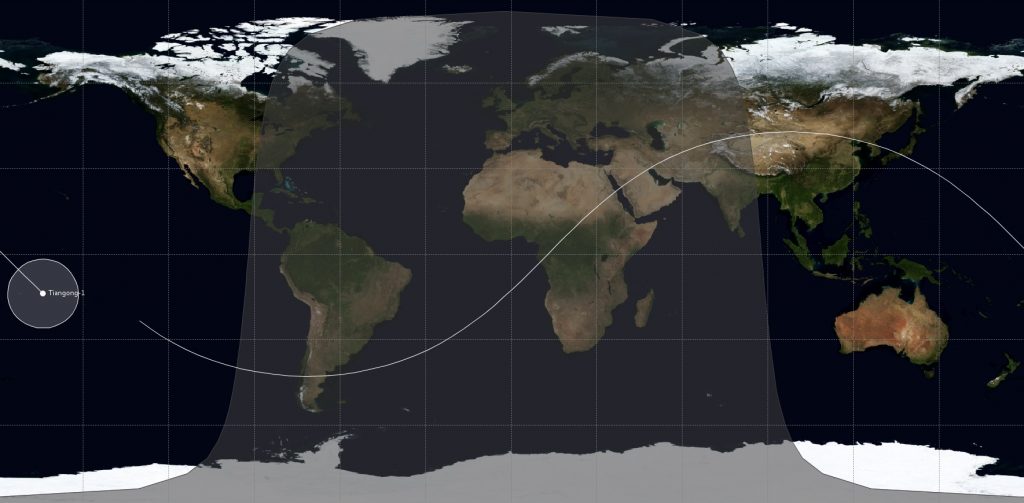
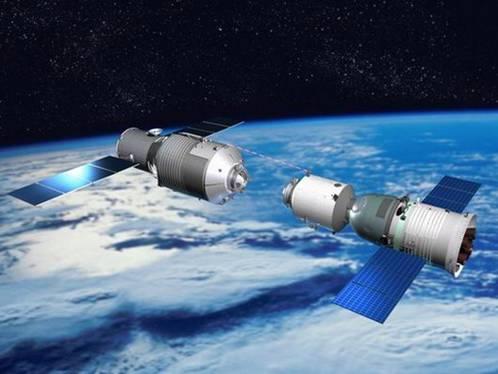
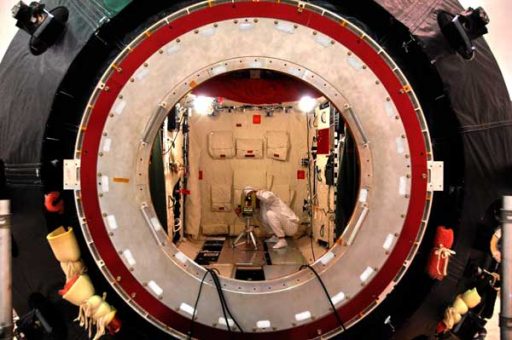
Tiangong-1 launched from the Gobi Desert on September 30, 2011 and first served as a docking target for China’s Shenzhou-8 proof-of-concept mission that sent an uncrewed spacecraft to demonstrate the country’s first docking maneuver in space – one of the essential techniques needed for the operation of a long-term space station. The space laboratory hosted two crews arriving on the Shenzhou-9 and 10 missions in 2012 and ’13 to demonstrate medium-duration habitation off the Earth via flights of 13 and 14 days, respectively.
Only stocked with a finite amount of supplies and limited life support capacity, Tiangong-1 was never envisioned to become a long-term outpost and had fulfilled its objectives under China’s crewed space program with the departure of the Shenzhou-10 spacecraft and its crew.
The end game for Tiangong-1 was to be a controlled deorbit maneuver through the use of its twin main engines to bring the complex down over a remote stretch of the Pacific Ocean known as the Spacecraft Cemetery – the final resting place of the Mir Space Station and future impact point of the remains of the International Space Station.
However, as Tiangong-1 was still admirably fulfilling its duties after the last crew departed, China’s Manned Space Engineering Office decided to keep the module in orbit for another two years to collect data on the longevity of its systems and to employ a pair of high-resolution imagers installed on its underside for various remote sensing applications. This mission extension eventually became opened-ended and was to continue as the craft’s fuel supplies permitted.
To remain at an operational altitude above 350 Kilometers, Tiangong-1 regularly fired its engines to counter drag in the upper atmosphere, very much like the International Space Station does to maintain its 400-Kilometer orbit. The last such firing occurred in November 2015 and the spacecraft was due for another in early 2016 when Chinese state media announced that Tiangong-1 had “ended data services” after a mission of 1,630 days – a polished way of saying the spacecraft was no-longer controllable from the ground.
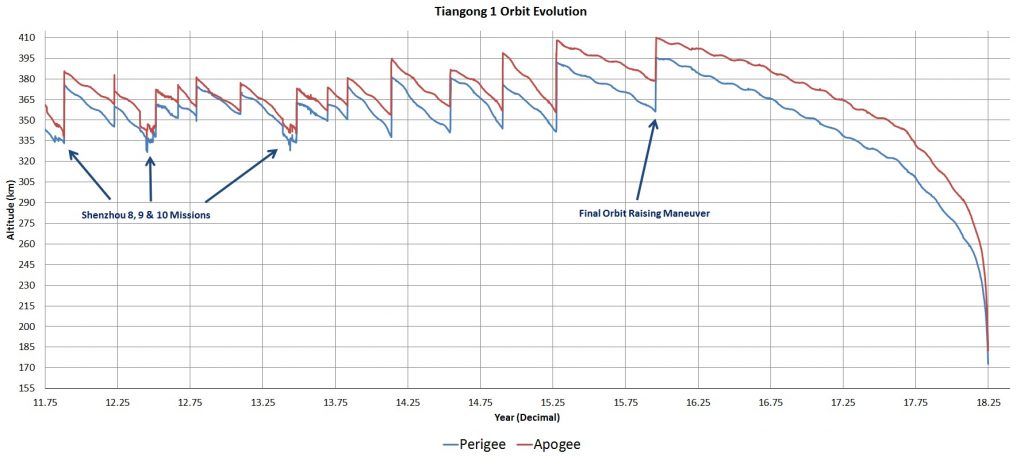
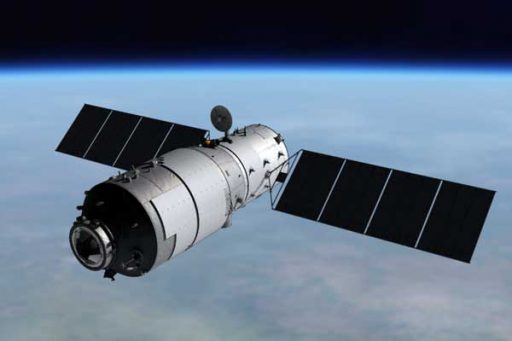
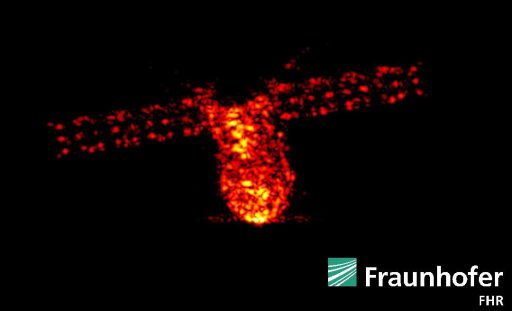
And so began an orbital decay process of two years as Tiangong-1 slowly dropped in altitude due to collisions with particles in the upper layers of Earth’s atmosphere creating a minute aerodynamic drag.
With a mass of around 7.5 metric tons when its tanks were running on empty, Tiangong-1 was by no means the heaviest object to make an uncontrolled re-entry – this record remains with NASA’s Skylab that re-entered in 1979. In fact, Tiangong-1 was not even the heaviest object to re-enter the atmosphere so far in 2018 – a Zenit rocket stage weighing some 8.3 metric tons rained down rocket parts over Peru in January, an event receiving very little to no international press coverage.
Initially losing altitude at glacial speed, Tiangong’s descent rate picked up considerably as it reached the denser layers of Earth’s lower thermosphere which expands and contracts in response to solar activity – creating a highly dynamic environment and making predictions of when and where re-entry could occur a difficult endeavor. Over the course of March, predictions zeroed-in on a late March re-entry, but Tiangong-1 received a slight life extension due to exceptionally benign solar activity – creating a very calm atmosphere for Tiangong-1 which in turn will make this particular re-entry interesting to the scientific community aiming to improve modeling processes for re-entry dynamics.
Tiangong-1 eventually met its end at 0:16 UTC ±1 minute on Monday morning, April 2nd after 2,375 days and 21 hours in orbit. Re-Entry, referencing the spacecraft crossing 80 Kilometers in altitude, occurred over the South Pacific Ocean at approximately 13.6°S 195.7°E, around 780 Kilometers due East of American Samoa.
>>Tiangong-1 Re-Entry Updates Page with Data on Tiangong’s final days in orbit
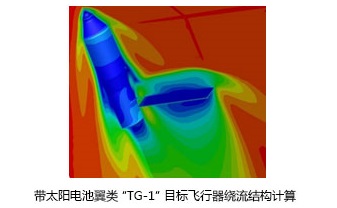
The location of re-entry was pin-pointed by the U.S. Joint Space Operations Center with the help of U.S. missile warning satellites outfitted with sharp infrared vision capable of identifying the signature of a re-entering piece of space debris or, in this case, an entire habitation module.
Re-entering the atmosphere with a kinetic energy of around 0.22 Terajoule, Tiangong-1 succumbed to an extreme combination of temperatures that can melt most metal alloys and a mechanical deceleration crushing even the strongest spacecraft structure. Tiangong’s solar arrays were first to break off some 90 Kilometers in altitude and simulations predicted the critical failure of the craft’s habitable pressure vessel around 65 Kilometers in altitude followed by the incineration of much of the spacecraft’s components.
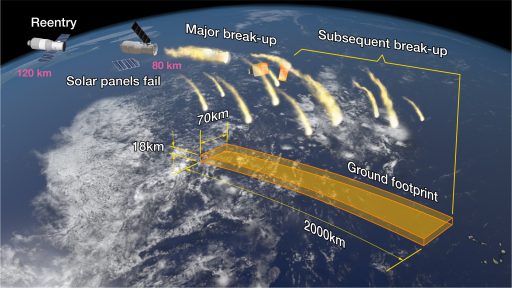
With a sizeable spacecraft such as Tiangong-1, a rule of thumb is that between 20 and 40% of its re-entry mass reach the ground – spread across a debris footprint around 2,000 Kilometers long and 70 Kilometers wide. A number of particularly sturdy components made the shortlist of candidates to survive the extreme entry environment, including the craft’s docking ring, the two Solar Array Drive Mechanisms, a pair of 20-liter pressurization tanks, parts of the main engines, and any hardened optical components used on the two large-aperture Earth imaging instruments.
Given the spacecraft’s decay point as provided by the Joint Space Operations Center, the entirety of the debris footprint lies over the open ocean and no surviving debris will have reached any major land mass. Some of Southern Cook Islands are located in close proximity to the center line of Tiangong’s entry track, though odds that any components landed on firm ground are extremely slim.
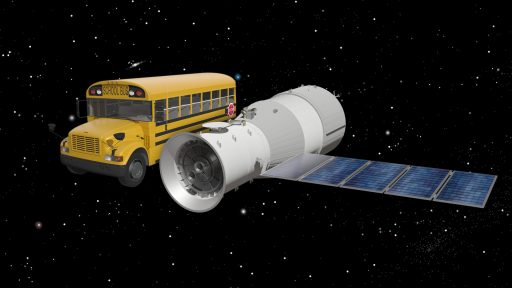
As the orbital life on one Tiangong ends, China continues operating the Tiangong-2 space laboratory – similar in size as the first one, though packed with upgraded systems as the country’s final stepping stone before upgrading to a larger, modular Space Station. Launched in September 2016, Tiangong-2 hosted two crew members for a 30-day stay to mark China’s longest human space flight to date. The craft also served as the docking target for the country’s first orbital logistics demonstration involving the Tianzhou-1 spacecraft that conducted several docking maneuvers and propellant transfers over a half-year mission – acquiring another critical tool for the operation of a long-term station in orbit.
With the departure of Astronauts Jing Haipeng & Chen Dong, and the success of Tianzhou-1, all primary tasks were finished for Tiangong-2 by September 2017. Through the fuel transferred from Tianzhou-1, Tiangong-2 could theoretically support an extended mission of several additional years. It remains to be seen whether China intends to avoid a repeat of Tiangong-1 and deorbits the successor craft before it is disabled by an onboard failure.
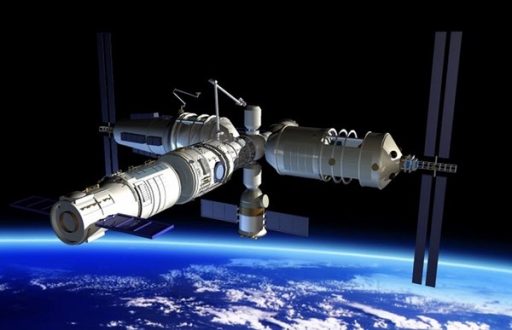
The two Tiangong missions laid the foundation for the Chinese Space Station, set to become a permanent outpost in space beginning in 2020 with the deployment of the Tianhe Core Module. At least two science modules, called Wentian and Mengtian, will be added to the core module with the help of a robotic arm and China also plans to operate a large free-flying Space Telescope in the same orbit as the station to make it easily accessible for maintenance missions.
The schedule of China’s Space Station was set back slightly by last-year’s failure of the country’s Long March 5 heavy-lift rocket on which the station and upcoming robotic exploration missions rely. Long March 5 is expected to return to flight later this year to clear the way for China’s Space Station to begin deployment in 2020.

